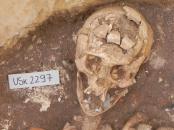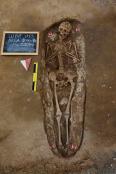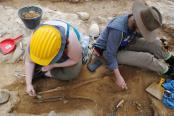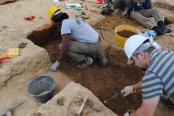CAMPAGNA 2013 |
1° SETTIMANA |
2° SETTIMANA |
3° SETTIMANA |
4° SETTIMANA |
5° SETTIMANA |
6° SETTIMANA |
7° SETTIMANA |
8° SETTIMANA |
28 GIUGNO 2013 
Resoconto della giornata di scavo
Area 1000
Nella giornata di oggi è stato finalmente completato l'allargamento dell'area di scavo verso est. La pulizia del settore B dell'area ha messo in luce la continuazione delle trincee di età moderna (UUSS -1147;-1133), della buca coeva alle trincee (US -1132) e della trincea di età contemporanea (US -1131) realizzata per condurre una tubatura al nuovo cimitero. Inoltre è stato completamente messo in evidenza la fondazione del perimetrale est della struttura che doveva addossarsi al transetto nord della chiesa. La rasatura appena scoperta presenta delle fasi di obliterazione costituite da uno strato a matrice mista di colore marrone scuro caratterizzato da un'alta concentrazione di frammenti di laterizi. Infine è da sottolineare che l'angolo nord-est di questa struttura è stato costruito con l'ausilio di una pietra angolare che fa pensare ad un riutilizzo in età moderna del materiale litico usato nelle fasi medievali di costruzione dell'abbazia.
This morning we finished cleaning the site from yesterday. Due to it raining last night, the dirt was easier to clean because it was softer. After cleaning, we looked at the colors of the dirt and determined that one of the trenches might have been a hole in the ground for a mulberry tree. We also hypothesize that some burials exist just north of the church, close to Area 2000. The backhoe was used as well, and out area was extended slightly to the east.
In the afternoon we cleaned the new parts of our area and worked on smoothing out all of its edges. Kailey and Steve worked with Alan on a wall on the eastern side of the site. However, we had to finish early because it started to rain. We then looked at 3D images created by photogrammetry and listened to a lecture on the history of Badia Pozzeveri.
Area 2000
Today at US2293, we continued to remove fill from the feature and attempted to find the cut. In the process, we found several bone fragments, including 3 left patellas (knee bones) in the fill as well as various long bone fragments. In addition, a porcelain tooth was found within the fill. At US2297, we finished exposing the skeleton in the cut. One particular set of grave goods was found with the skeleton: a pair of copper and gold earrings. We also determined that the skeleton was that of an adult female, which was hypothesized on the premise of the width of the pelvis. The skeleton and burial site was documented with pictures and biometric measurements. Then, all of the bones of the feet were removed, labeled and stored. Photogrammetry and GIS points were also taken of the burial site and surroundings. At US2285, we finished removing the skull that was in the cut, and an unidentified bone was found behind the skull. GIS points were also taken here, where the skull was found. After, we continued removing the fill and a layer of lime was found, as well as what we believe to be a potential burial site on account of the presence of a femur and ulna that were found there. A partial mandible and teeth attached to a part of alveolar bone was also found above the lime layer.
Area 3000
Continua lo scavo della fossa rettangolare US – 3220, orientata W-E e tagliata dalla trincea US – 3223. All’interno del secondo livello di riempimento (US 3230) sono stati rinvenuti alcuni chiodi ed un oggetto di ferro la cui forma ricorda quella di un peso a piombo o un punteruolo. La sezione est della fossa presenta un grande arrossamento, probabilmente il risultato di un’attività di fuoco, forse la presenza originaria di un crogiolo in cui è stata raggiunta una temperatura elevata, come sembra confermare il ritrovamento di un numero cospicuo di laterizi concotti, ceramica da fuoco, scorie metalliche e vetrificate e numerosi scarti di fusione. Non è ancora possibile determinare con certezza la funzione di questa buca regolare, anche se potrebbe essere ipotizzata una sua connessione con le numerose attività di cantiere di epoca moderna, che comprendono anche la grande fossa (US 3107) che ospita alcune basi di appoggio per la fusione ed il getto delle campane. Lungo il muro USM 3073 continua la messa in evidenza dell’individuo medievale Us 3244, orientato W-E, i cui arti superiori sono stati intercettati ed asportati dallo scavo della trincea di epoca moderna. Nel Settore B è stata individuata una fossa sepolcrale al cui interno è deposto lo scheletro Us 3248, orientato N-S, che sarà messo in luce nei giorni seguenti.
In the morning the crew working at Section 3000 of the site was divided into three groups to excavate both Subsections A and B at of the Section. Two people would work in Subsection A (Team A1) and two groups of two people would work in different areas of Subsection B (Team B1 and Team B2). Later in the afternoon all teams were instructed to continue their previously designated tasks.
Team A1 was instructed to further excavate a small pit approximately 1m x 1m in dimension in the center of Subsection A. The earth was of a sandy consistency but was heavily laden with brick, mortar, and slate. After removing about 4cm of the surface pottery shards were found. The surface was then carefully exposed with dental tools, photographed, and the pottery shards removed.
Team B1 excavated area 3241 on the southern boundary. The area was approximately 150cm long in an oval shape and the earth was laden with brick and mortar stone. It appears that there is a color difference in the soil compared to the surrounding area. At first the soil consisted of a sandy loam about 4cm deep which was excavated. The layer eventually faded to a darker layer of sandy loam clay with a high percentage of brick, mortar, and slate. This layer was excavated for the remainder of the morning.
Team B2 excavated area 3xxx on the south side of the primary wall in the center. Team 2B expected to find a burial against and/or within the primary lithic wall. They started by leveling out the center of the trench that ran adjacent to the wall. They then began systematically excavating the area level by level. After much excavation they found human skeletal remains in the context of what could be considered a “coffin” type burial in that the remains appeared oriented from West to East.
In the afternoon, Team A1 continued to excavate the 1m x 1m pit. After about another 4cm glass fragments with a green hue were found in the northeast corner of the pit and are believed to be from a beer bottle. Another 4cm was removed from the surface and a bronze buckle about twice the size of a stamp was found. The pit was then taken down another 4cm with the goal of making it level with a parallel trench tomorrow. Another 1m x 1m pit about 1m East of the first was also leveled with the same intention of joining multiple pits together.
Team B1 continued with their task of investigating a possible burial. They found a mix of bone fragments, a few of which were identifiable although the majority was not. After about 28cm of total digging two bones were found but further excavation is still required to uncover the extent of the bones and their context.
Team B2 also continued with their previous work. After a short time they were able to uncover and identify foot bones, a femur, some metacarpals, and even a patella. They then worked to remove sediment from and around the bones. It is not yet clear how much more of the skeleton there is to uncover. It is however believed that there may be an additional burial underneath this “lithic coffin” style burial, which would be consistent with medieval era burial practices.
Area 4000
Settore A
Continua l’indagine nel Saggio 4800 (angolo nord orientale del settore) con la rimozione di US 4892 (=US 4092 Sett. A), uno strato argilloso di elevata compattezza e spessore. Come anticipato precedentemente la sterilità archeologica della US è stata smentita dal continuo, anche se sporadico, ritrovamento di manufatti ceramici e resti ossei umani (privi di connessione). La genesi deposizionale dello strato con conseguente dilavamento dei suddetti reperti da una quota più elevata, pare essere sempre più confermata.
Settore B
Prosegue lo scavo della fase di risistemazione del periodo post-abbandono dell’area, con conseguente indagine di US 4109, US 4108 ed US 4107. Oltre agli specifici rapporti fisici fra questi tre contesti è stata individuata al di sotto di essi, una nuova unità stratigrafica a matrice argillosa, forte elasticità e colore marrone tendente al giallo, molto simile ad US 4092 del Sett. A; studiando gli strati precedentemente rimossi nel suddetto settore si può notare una forte uguaglianza con le situazioni presenti al di sopra di, appunto, US 4092; è dunque ipotizzabile (e confermabile nell’immediato futuro) che un simile contesto sarà riscontrabile al di sotto di questa nuova US. Lo scavo stratigrafico permetterà di confermare o smentire suddetta ipotesi.
Settore C
È stato avviato, ad Est e Nord del Sett. B, un allargamento, tramite l’ausilio di mezzo meccanico, dell’area. Questo ulteriore specchio di indagine verterà alla comprensione generale della zona a Sud della chiesa, verificando eventuali anomalie geomorfologiche riscontrate tramite l’uso del georadar, oltre che a confermare l’ipotesi secondo la quale si stia scavando all’interno di un contesto monasteriale piuttosto che altro. In concomitanza con il lavoro da svolgere nel Sett. B, verrà eseguita, in questo nuovo allargamento, una prima pulizia generale sino a raggiungere, stratigraficamente, i contesti rilevati in B; così da avere uno spettro di indagine più ampio ma coerente.
We are continuing to pick-axe to expose new contexts. Tree roots cut through the newly expose contexts which from their own separate, naturally occurring contexts. As we cleared the area, potter, nails, and bone fragments were found. The backhoe began to enlarge the area and started to form Section C of area 4000. After the backhoe left for the day we continued to pick through section B and trowel section C. We found what may be the remains of a wall in Section C but our excavation was halted by late afternoon showers.













